Swedish bayonet belt frogs

Introduction
Belt frogs for the Swedish bayonets is an area not very well researched. I will try to describe some of the more common frogs.
Early frogs
There are very few earlier belt frogs left, and they are poorly documented.
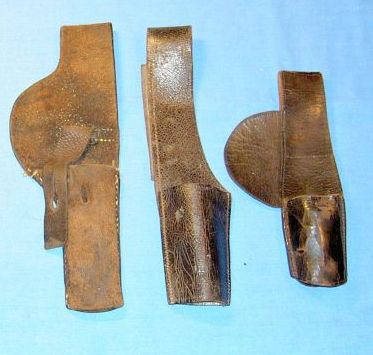 |
From left to right
- Frog for socket bayonet m/1867 and
m/1867-89.
- Unknown
frog from later half of 1800. It was found on a m/1860
school bayonet. It is modified as the "ear" is cut off. This model was
probably used on most socket bayonets up to m/1867.
- This frog was found on a m/1815 scabbard but it was probably used with most 1800 army models.
|
There are also combination frogs for both bayonet and another side arm.
m/1867 and m/1867-89 socket bayonets
 |
The older types of frogs (see
above) was probably used with m/1867 bayonets as well, but this is the
"common " model used for both m/1867 and
m/1867-89.
|
m/1867 sword bayonet
When the navy received their sword bayonets in the 1870's
they manufactured frogs from old material (e.g. old frogs, pouches etc).
The navy frogs were black.
When the Costal Artillry was formed, they received cutlass m/1903 made
from bayonet m/1867. The frog m/1903 is in brown leater and is
used with belt m/1903.
Note, the designation of the belt and frog (m/1903) is not yet confirmed !
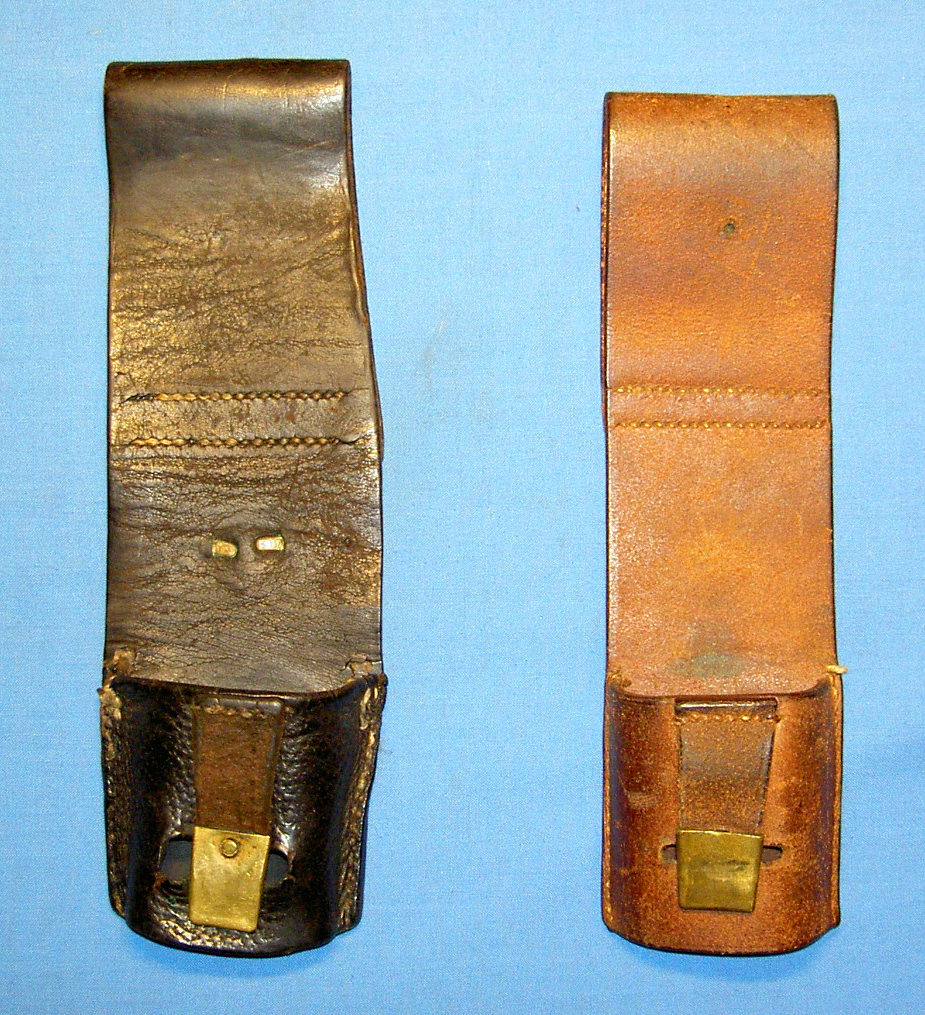 |
From left to right
- Frog for sword bayonet m/1867 for the navy.
- Frog m/1903 for Coast artillery cutlass m/1903.
The designation m/1903 is ot yet confirmed !
|
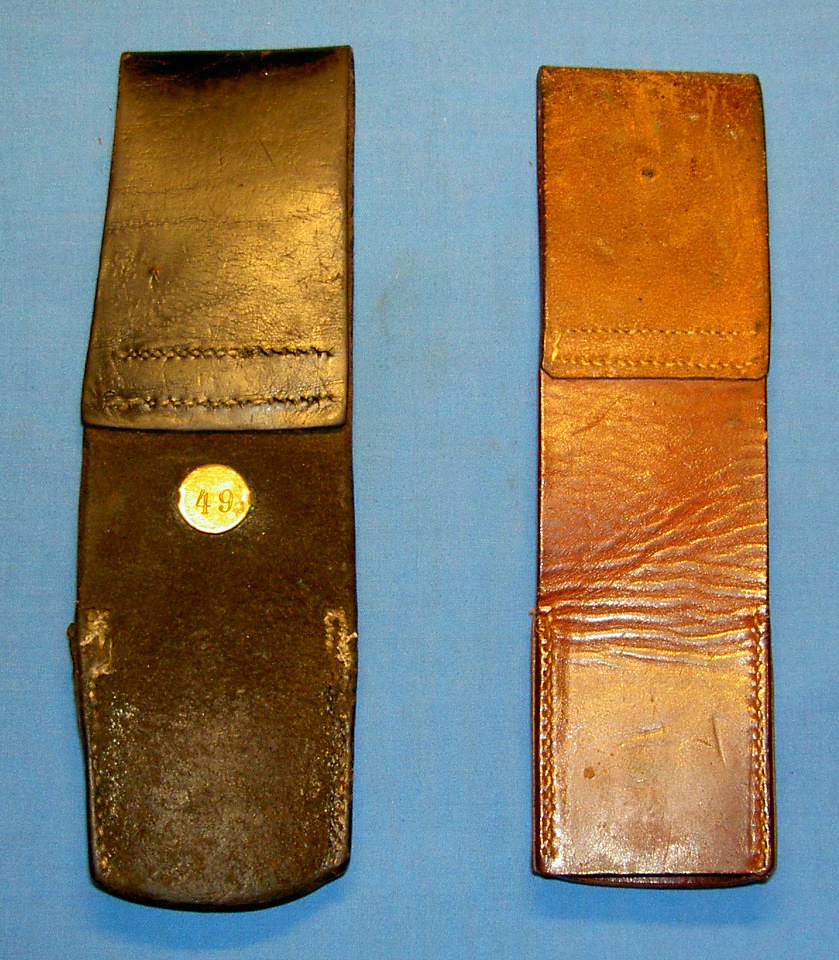 |
Rear view of the same frogs. |
m/1896
The bayonet was approved 15th October
1897 according to General Order #1329. A leather frog was also approved
in the same GO. In May 1900 a new frog was approved..
I have not been able to find any drawings (yet) on the different
models, but one may speculate that the first versions did not
have any locking straps. They were added after a few years.
Many frogs were changed to fit belt
m/59. (They are marked with 'B' on he strap). The frog is shorter
and the loop is wider.
The home guard however, used the long frog well int the 1970's.
Here are a number of m/1896 frogs.
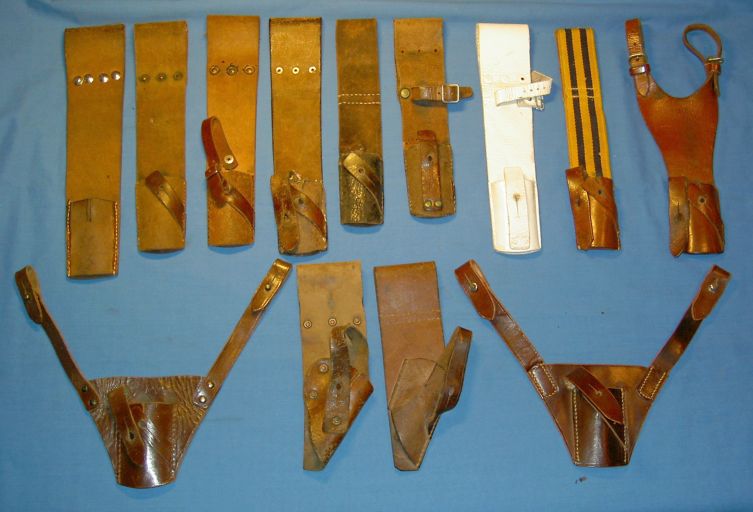 |
|
From left to right, first row, second row:
- Long model with no straps. (Can be found sewn or riveted)
- Long model with one strap. (Can be found sewn or riveted)
- Long model with two straps. (Can be found sewn or riveted)
- Long model with two straps. (Can be found sewn or riveted)
- Short model with one strap. Probably a very early model.
- Short model , modified for belt m/59
- Parade
- m/1910 for parade belt m/1910
- m/1939 (for belt m/1939)
- m/1923 (for belt m/1923). Riveted straps.
- For mounted troops (cavalry, artillery etc), riveted. Can be found for both m/1914 and
m/1896.
- For mounted troops (cavalry, artillery etc), sewn. Can be found for both m/1914 and
m/1896.
- m/1923 (for belt m/1923). Sewn straps.
|
A number of frogs for bayonet m/1896 were made for private purchase. Most were made to be carried with a Sam Browne type belt.
Here are a few models:
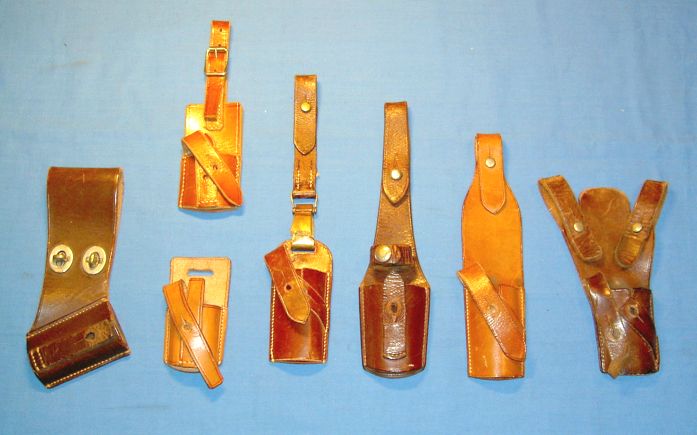 |
From left to right:
- This is an odd model sold by MEA (Militär Ekiperings Aktiebolaget). It was however to expensive to be popular.
- Upper, Unknown model
- Lower, Unknown model.
- Unknown model.
- Unknown model.
- Unknown model.
- This one is not a modified m/1939 frog, it is made like this.
|
Yet some more m/1896 models.
 |
From left to right:
- Unknown model. Looks very similar to #7 above. Sabe strap distance.
- Unknown model.
- Unknown model.
|
In 1940's there were some trials for a combination frog .
 |
Combination frog.
It was never accepted, just on trial. |
m/1914
We have basically the same frogs for bayonet m/1914 as for m/1896.
Please note that it is NOT the same frog for bayonet m/1914 as m/1896 ! See details here.
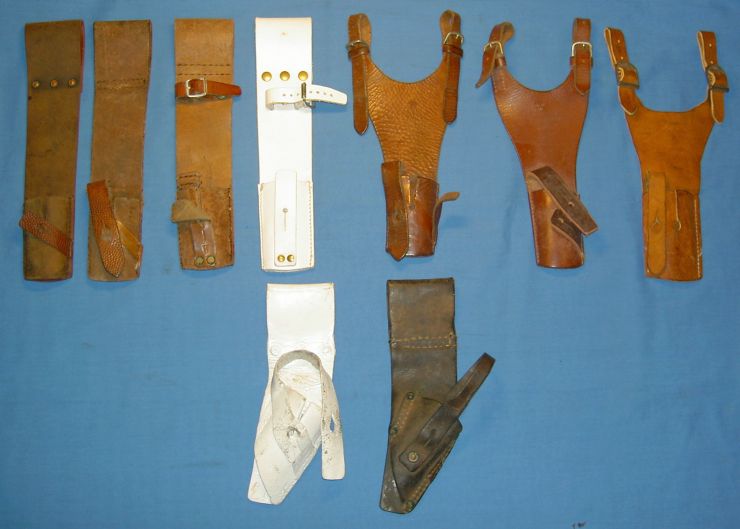 |
|
From left to right, first row, second row:
- Long model, one strap.
- Long model, two straps.
- Short model , Modified for bandoliere m/59
- Parade..
- m/1939 (For belt m/1939). Marked with one crown.
- m/1939 (For belt m/1939). Marked with three crowns.
- m/1939 (For belt m/1939). Made in different material.
- Mounted troops, parade model.
- Mounted troops, regular model (sewn and riveted)
|
m/1915
There is basically one model frog for bayonet m/1915. (there are variations though).
Note, bayonet m/1915 was not carried in a m/1896 or m/1914 frog..
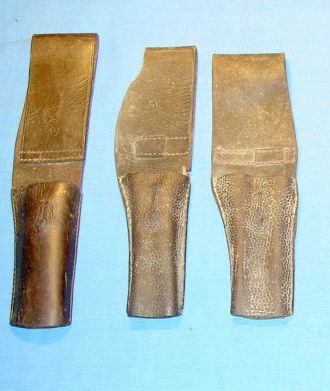 |
| Frogs for bayonet m/1915. |
m/1939
The bayonet m/1939 (i.e. German bayonet S84/98) was carried ín a modifiedm/1914 frog.
m/1965
The AK4 bayonet m/1965 has an integrated web frog. The parade version has a white leather frog.
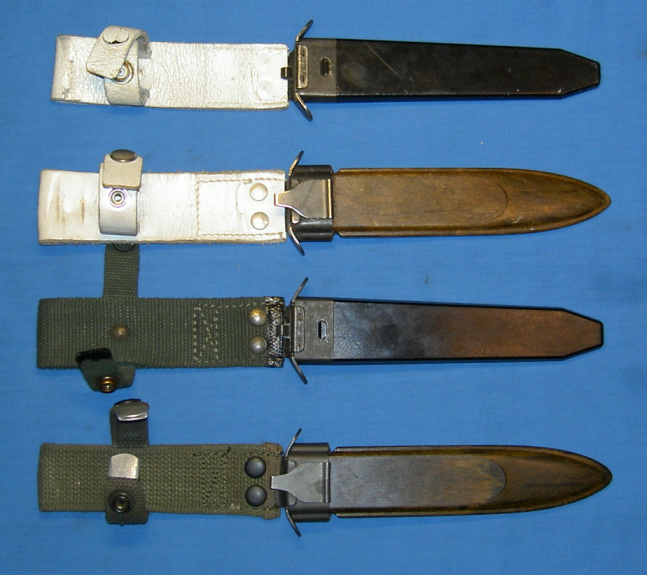 |
From top to bottom:
- late model, parade
- early model, parade
- late model
- early model
|
Experimental models
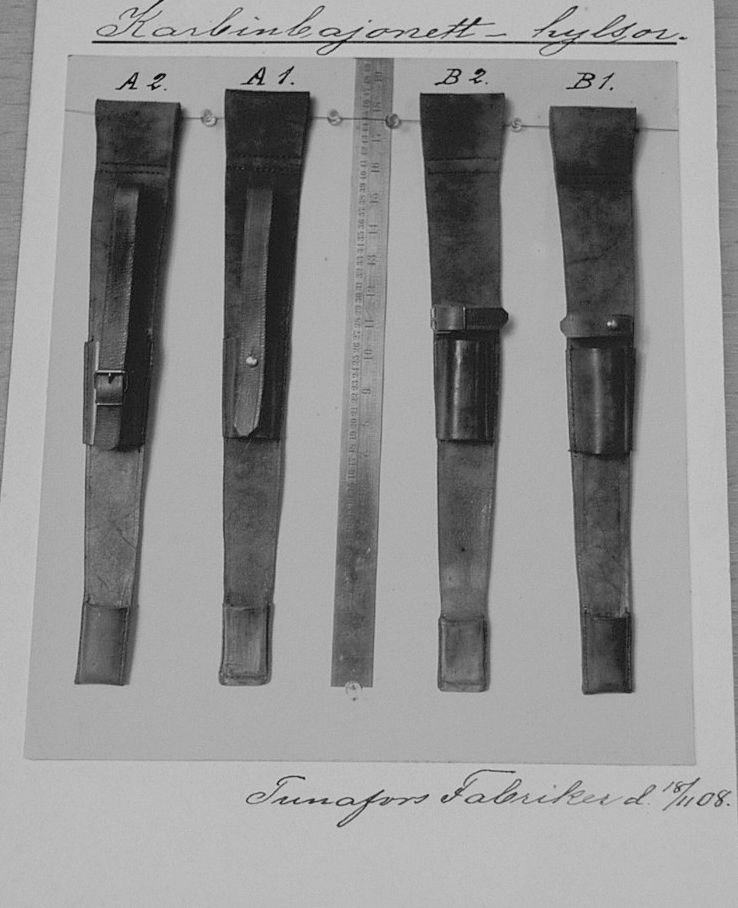 |
|
Here are a couple of frogs for a Swedish trial bayonet (fm/08 folding carbine bayonet). |
Difference between m/1896 and m/1914 frogs
The objectives of this chapter is to show on the differences between the frog for the m/1896 and the m/1914 bayonets.
On basically every auction site you see bayonet m/1914 (and m/1915 as well) being sold with frogs for m/1896.
Neither m/191 or m/1915 shall be mounted in a m/1896 frog !
The major difference between the m/1896 and the m/1914 is that the frog
stud is about 22 mm from the mouth piece on the m1896 bayonet and about
25 mm on the m/1914 (and m/1915) bayonet. The scabbard shall
(obviously) be mounted just one or two mm below the mouthpiece.
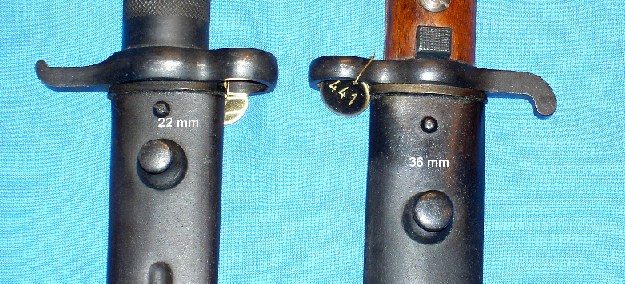 |
| A m/1896 scabbard to the left and m/1914 to the right |
Most frogs can be found for both m/1896 and m/1914. The pictures below
clearly shows the difference; the longer slot on the m/1914 frogs.
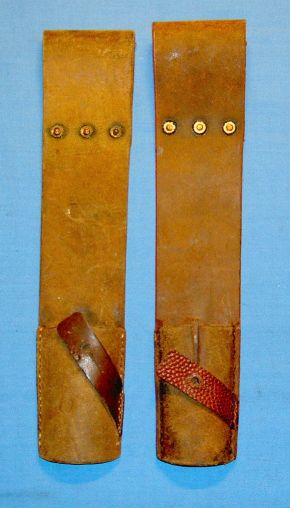 |
Frog for m/1896 at left and m/1914 at the right.
The difference is clear here.
|
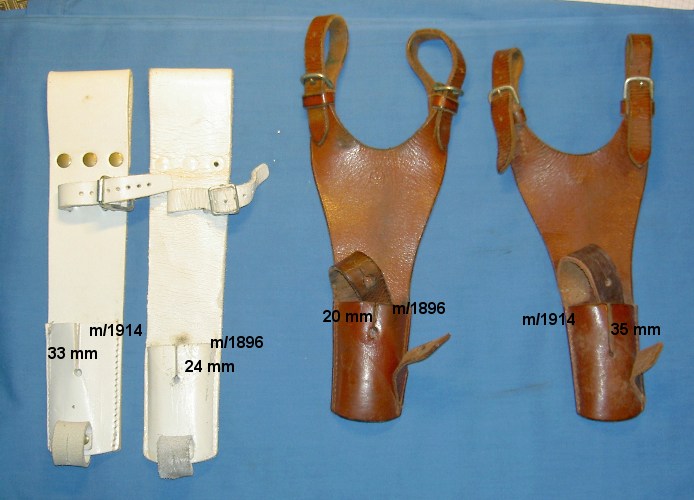 |
| Here are the parade frog and an m/1939 NCO frog where you clearly see the difference. |
Cross Draw
The sow called "cross draw" frogs where used by the mounted troops and where used with both m/1896 and m/1914 bayonets.
The frog may be found with both the long slot for the m/1914
bayonet and she short slot for m/1896 bayonet. Here I am not so sure
the distinction is quite so clear.
The m/1914 fits perfectly well in some short slot frogs and vice versa. The frogs with long slot is quite scarce as well.
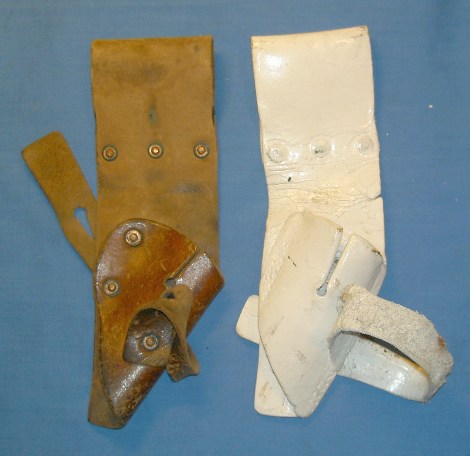 |
| Two "cross draw" frogs (Mounted troops); short slot at left, long slot at right. |
Last updated 2009-02-03
©Per Holmbäck










